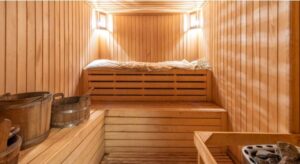DIY Tips for Building a Sauna at Home
Imagine unwinding in the comfort of your own home, enveloped in soothing warmth. Building a sauna at home isn’t just a dream, it’s an achievable project that offers relaxation and numerous health benefits. Whether you’re an experienced DIY enthusiast or a beginner, creating your personal sauna can be a rewarding challenge that adds value to your home.
Before you dive into this project, it’s essential to know the basics. From selecting the right materials to understanding the necessary space requirements, a few strategic decisions can make all the difference. With the right tips and guidance, you can transform an unused corner of your house into a tranquil oasis.
In this article, you’ll discover essential DIY tips to help you build a sauna that fits your lifestyle and budget. Get ready to embark on a journey toward creating a space that’s all about relaxation and rejuvenation.
Key Takeaways
- Building a sauna at home is achievable for both DIY enthusiasts and beginners, offering relaxation, health benefits, and increased property value.
- Choosing the right location involves assessing accessibility, ventilation, privacy, structural integrity, and compliance with local building codes.
- Key materials include high-quality woods like cedar or spruce, efficient heaters, and proper insulation to ensure durability and energy efficiency.
- Safety considerations encompass electrical installations, fire prevention, structural stability, proper ventilation, and health precautions for users.
- Effective budgeting involves planning for materials, tools, professional help, and permits while allowing for unexpected expenses and focusing on energy efficiency for long-term savings.
Benefits of Building a Home Sauna
Creating a home sauna provides both health and lifestyle advantages that elevate your living experience. By incorporating a sauna into your property, you enjoy a unique space for relaxation and wellness.
Health Benefits
Regular sauna use promotes cardiovascular health. It enhances circulation because heat causes blood vessels to dilate. Saunas also support detoxification.
Sweating helps remove toxins through your skin. Additionally, using a sauna can relieve muscle tension and joint pain. The warmth effectively soothes discomfort and encourages relaxation.
According to the Mayo Clinic, saunas may also improve mental health by reducing stress and promoting a sense of well-being.
Convenience and Privacy
Having a sauna at home offers unmatched convenience. You can enjoy a session any time without the need to travel. There’s also the element of privacy.
Your sauna space ensures that you relax without interruptions from others, making it a perfect personal retreat.
Property Value Increase
Installing a sauna can boost your property’s value. Homebuyers often find unique amenities appealing, and a well-built sauna may be a distinguishing feature.
A sauna sets your home apart from others on the market, potentially providing a competitive edge.
Energy Efficiency and Cost Savings
A home sauna contributes to energy efficiency if you choose the right materials and insulation methods.
High-quality insulation retains heat, resulting in lower energy consumption. Over time, these efficiencies translate into cost savings on utility bills.
Customization Options
Building a sauna yourself allows for complete customization. You can select specific dimensions, materials, and design elements to fit your style and space needs.
Whether you prefer a traditional wood aesthetic or a more contemporary setup, the possibilities are endless, ensuring a sauna that complements your home.
Family Bonding and Entertainment
A sauna can become a central hub for family bonding. It offers a unique setting for quality time, fostering connections and conversations.
Additionally, it serves as an entertainment feature. A sauna adds an added element of interest to gatherings at your home.
Year-Round Enjoyment
Unlike outdoor pools or seasonal amenities, your sauna provides year-round enjoyment. Whether it’s the depths of winter or the heights of summer, a sauna remains a haven for warmth, comfort, and relaxation.
By focusing on the numerous benefits a home sauna brings, you recognize the value it adds to both your health and property. Enrich your lifestyle through this rewarding DIY project that offers ongoing advantages for years to come.
Choosing the Right Location
Selecting an optimal location for your home sauna is crucial for functionality and comfort. Consider these factors to ensure your sauna complements your living space.
Accessibility
Place your sauna in a space that’s easily accessible from your home. Proximity to a water source and power supply can simplify both construction and usage.
Basements and unused bathrooms can be ideal locations due to existing plumbing and electrical infrastructure.
Ventilation
Ensure proper ventilation to maintain air quality and prevent moisture buildup. Choose a location where you can install a ventilation system without extensive modifications.
Garages or buildings might require additional considerations to achieve adequate airflow.
Privacy
Maintain privacy to enhance the relaxation experience. Select a space that offers seclusion from the main living areas.
Transforming part of an existing room with partitions can create a private environment within your home.
Available Space
Verify your chosen location has enough space to accommodate the sauna structure and any additional features you may desire, like benches or a changing area.
Measure to ensure the space suits your design plan while allowing for safe operation and comfortable use.
Structural Integrity
Assess the structural integrity of the area to support the weight of the sauna and its components.
Your chosen location should have a sturdy foundation and be free of any structural issues. This is essential for long-term stability and safety.
Compliance
Review local building codes and regulations before finalizing your sauna location. Compliance ensures your sauna meets safety standards and keeps the installation process legal and hassle-free.
Consult with local authorities to understand any specific requirements related to your choice of location.
By considering these essential factors, you can choose the right location for your home sauna, ultimately creating a functional, comfortable, and rewarding DIY project.
Essential Materials and Tools
Choosing the right materials and tools is crucial for building a functional and long-lasting sauna at home. Selecting premium-grade items ensures efficiency and durability.
Wood Selection
Wood choice defines the sauna’s atmosphere and resilience. Opt for softwoods, which are popular for their insulating properties and low heat conduction. Cedar and spruce are top choices due to their aromatic qualities and resistance to cracking under high temperatures.
Cedar provides a natural, pleasant aroma and deters insects while maintaining a cool surface in heated environments. Spruce, known for its strength, contributes to a traditional Nordic look.
Avoid woods with high resin content, like pine or fir, to prevent unpleasant odors or sticky surfaces during use.
Heaters and Insulation
Efficient heaters and proper insulation sustain your sauna’s temperature while optimizing energy use. Electric heaters rank as a convenient and reliable option, offering adjustable thermostats for controlled heating.
Consider infrared heaters if you prefer gentler heat, though they’re typically less traditional. Wood-burning stoves provide an authentic experience but require adherence to precise chimney specifications. Insulating your sauna is essential for maintaining heat and reducing energy consumption.
Use fiberglass or reflective foil insulation tucked between walls and ceilings to create an efficient thermal barrier. Employ vapor barriers like aluminum foil to prevent moisture accumulation and wood damage.
Ventilation Requirements
Proper ventilation impacts air quality and comfort in your sauna. Well-designed airflow prevents condensation and maintains a steady oxygen level. Install intake vents near the floor to introduce fresh air and exhaust vents near the ceiling to expel hot, moist air.
Ensure openings are covered to avoid drafts while preserving warmth. Adjustable vents offer control over airflow, enhancing comfort during sessions.
For more elaborate designs, consider integrating a mechanical ventilation system to maintain a consistent and controlled environment.
Step-by-Step DIY Sauna Construction
Building a sauna at home can be a rewarding project when broken down into manageable steps.
Begin by preparing the foundation, move on to framing and insulating, and finish with installing the sauna heaters for a complete DIY setup.
Preparing the Foundation
Establishing a solid foundation creates stability for your sauna. First, choose a leveled area to prevent structural imbalances.
If necessary, use a concrete slab or pier blocks, particularly in outdoor or non-concrete locations. Check for smoothness with a level tool to avoid issues during construction.
Ensure drainage systems are in place for moisture management, which is especially crucial in basements or moisture-prone areas. It’s equally important to consider accessibility for plumbing and electrical work. Proper planning here simplifies later stages of the build.
Framing and Insulating
For the sauna structure, construct a sturdy frame using high-quality lumber. Assemble the frame with 2×4 or 2×6 wooden studs, ensuring equal spacing, commonly 16 inches apart, for adequate support. Fit the pieces securely for a reliable interior setting.
Next, focus on insulation to maintain temperature and energy efficiency. Use high-grade options, like foil-backed insulation, to reflect heat inward and retain warmth.
Ensure a snug fit between studs, avoiding gaps that could lead to heat loss. Seal seams with vapor barriers to prevent moisture from penetrating insulation layers.
Installing Sauna Heaters
Correct heater installation ensures an effective sauna experience. When selecting a heater, consider electric models for effortless operation. Many DIY builders prefer them for their straightforward setup and control.
Mount the heater following manufacturer instructions, usually positioning it centrally for even heat distribution. Consider adding heat shields for safety, preventing direct contact with the walls. Connect the heater to a dedicated power line to avoid electrical overloads, and ensure it’s properly grounded for safety.
Each stage from foundation to heater installation requires attention to detail and careful execution. By following these steps, you create a functional, efficient, and enjoyable home sauna.
If you are looking to buy a new electric sauna heater or upgrade your sauna setup, explore the best sauna heaters at Sauna Heater Supply. With a wide range of top-quality, efficient models, we have the perfect solution to match your needs.
Safety Considerations
When building a home sauna, ensuring safety is crucial to avoid potential hazards. Follow these guidelines.
- Electrical Safety: Hire a licensed electrician when installing heaters and lighting. Ensure all electrical fittings are compliant with local codes to prevent electrical fires and accidents.
- Ventilation and Air Quality: Proper ventilation is vital. Design your sauna to include vents that allow fresh air to circulate. This prevents excessive humidity and reduces the risk of mold growth.
- Fire Safety: Use fire-rated materials for walls and ceiling near heaters. Install smoke detectors outside the sauna. Keep flammable items away from heating elements.
- Structural Integrity: Check that the sauna can withstand extra weight and heat. Securely frame and insulate the structure, using durable materials to prevent warping and collapse over time.
- Door and Exit: Install a door that opens outward, not requiring locks, to provide a quick escape in emergencies. Ensure the door isn’t obstructed by other structures or furniture.
- Temperature Control: Integrate a reliable thermostat to monitor sauna temperature. Avoid exceeding recommended heat levels to prevent overheating and associated risks.
- User Health Precautions: Limit sauna use to a safe time duration, usually not exceeding 20 minutes, particularly for those with medical conditions or pregnant individuals.
- Water Safety: If using a steam generator, ensure the water supply is clean to prevent contamination. Regularly maintain and clean water lines.
By adhering to these considerations, a safe and comfortable sauna environment can be achieved, enhancing your home’s value and your personal wellness.
Cost Estimation and Budgeting
Building a sauna at home involves strategic cost estimation and budgeting to ensure financial feasibility. Understand the cost components and prioritize budget allocations effectively.
Key Cost Components
- Materials: Expenses typically include wood (e.g., cedar, spruce), insulation, heaters, and benches. Quality influences longevity and performance, so investing in durable materials can save long-term costs. For example, premium-grade cedar ranges from $2 to $4 per linear foot.
- Tools: Budget for essential tools like saws, hammers, drills, and safety equipment. If you’re buying new tools, consider tool rental options to minimize expenses. A standard toolkit might cost around $100 to $300.
- Installation: Consider if professional help is necessary for electrical installations and complex tasks. Electricians may charge between $50 and $100 per hour. Weigh the benefits of professional installation against your DIY capabilities.
- Permits and Inspections: Verify if local regulations require building permits or inspections. Permit fees vary by location, potentially affecting overall costs. Contact your local municipality to avoid unexpected expenses.
Budgeting Strategies
- Research and Plan: Compare prices from multiple suppliers and check for sales or discounts on materials. Avoid hurried decisions by aligning your purchases with a detailed plan.
- Seek Estimates: Obtain quotes from professionals for tasks beyond your expertise, such as electrical and plumbing work. These estimates help identify whether parts of the project can be DIY or need professional handling.
- Prioritize Spending: Focus on essential components such as structure and safety features before investing in optional amenities like audio systems or custom lighting which can raise costs substantially.
- Track Expenses: Keep a record of all expenditures. This practice not only helps manage your budget throughout the project, but it also provides a comprehensive reflection of your total investment.
Managing Unexpected Expenses
- Reserve Funds: Always allocate 10% to 20% of your budget for unforeseen costs. These might arise from delays, price fluctuations, or modifications during construction.
- Address Cost Overruns: If overruns occur, evaluate areas where you can adjust scope or material choice without compromising safety or quality. Consider less costly alternatives when necessary.
- Look for Repurposed Materials: Salvaged wood and reused fixtures can bring down expenses without reducing quality. Check local salvage yards or online marketplaces for affordable options.
- Embrace DIY: Manage simpler tasks like painting, sealing, and assembling benches yourself to cut labor costs. Engaging in DIY tasks contributes to learning and personal fulfillment while reducing expenses.
- Energy Efficiency: Invest in energy-efficient heaters and proper insulation. While initially pricier, they save money on utility bills in the long run, enhancing overall project value.
Approaching your sauna project with clear cost estimation and effective budgeting ensures a rewarding experience that aligns with financial constraints while achieving personal goals.
Conclusion
Building a sauna at home is a fulfilling DIY project that offers numerous personal and property benefits. By understanding the essentials and following the right steps, you can create a serene space tailored to your needs.
Prioritize safety and budget wisely to ensure a successful build. With careful planning and execution, your home sauna will become a cherished retreat for relaxation and wellness.
Frequently Asked Questions
What are the main benefits of having a home sauna?
A home sauna offers numerous benefits, including improved cardiovascular health, detoxification, stress relief, and increased property value. It also provides privacy and convenience, allowing you to enjoy its comforts without leaving home.
Additionally, a home sauna can be a space for family bonding and entertainment, offering year-round enjoyment.
What should I consider when choosing a location for my home sauna?
Choose a location with easy access to water and power sources, proper ventilation, and adequate privacy.
Ensure the chosen area has enough space, structural integrity, and complies with local building codes and regulations.
What materials are recommended for building a sauna?
Use premium-grade materials for efficiency and durability. Softwoods like cedar and spruce are ideal for their insulating properties and aromatic qualities.
Avoid high-resin woods. Choose electric heaters for convenience and ensure proper insulation to maintain temperature and reduce energy consumption.
How can I ensure proper ventilation in my home sauna?
Design airflow systems that maintain air quality and comfort. Install vent grills at appropriate locations to facilitate air movement and prevent humidity buildup.
Proper ventilation helps maintain the sauna’s environment, preventing mold growth and ensuring a safe experience.




